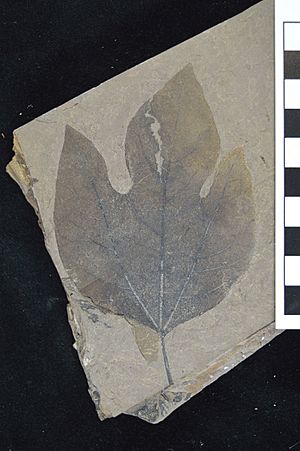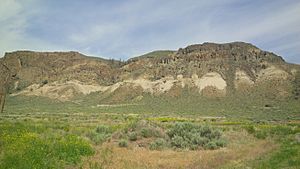McAbee Fossil Beds facts for kids
The McAbee Fossil Beds is a Heritage Site that protects an Eocene Epoch fossil locality east of Cache Creek, British Columbia, Canada, just north of and visible from Provincial Highway 97 / the Trans-Canada Highway (Highway 1). The McAbee Fossil Beds, comprising 548.23 hectares (1,354.7 acres), were officially designated a Provincial Heritage Site under British Columbia's Heritage Conservation Act on July 19, 2012. The site is part of an old lake bed which was deposited about 52 million years ago and is internationally recognised for the diversity of plant, insect, and fish fossils found there. Similar fossil beds in Eocene lake sediments, also known for their well preserved plant, insect and fish fossils, are found at Driftwood Canyon Provincial Park near Smithers in northern British Columbia, on the Horsefly River near Quesnel in central British Columbia, and at Republic in Washington, United States. The Princeton Chert fossil beds in southern British Columbia are also Eocene, but primarily preserve an aquatic plant community. A recent review of the early Eocene fossil sites from the interior of British Columbia discusses the history of paleobotanical research at McAbee, the Princeton Chert, Driftwood Canyon, and related Eocene fossil sites such as at Republic.
The McAbee Fossil Beds reopened for public viewing on June 21, 2019. The McAbee site is now under the management of the Bonaparte First Nation, who have title on the lands.CBC News
Contents
Palaeontology and Geology
Fossil plants from the same area as the McAbee fossil beds (Cache Creek and Kamloops B.C.) were first reported by G.M. Dawson. Palaeontological and geological studies of the McAbee Fossil Beds are more recent, however, going back at least to research in the 1960s and early 1970s by Dr. Len Hills of the University of Calgary and his students on the fossil spores and pollen (palynology) and the leaf fossils, and research on the fossil fish from the fossil beds by Dr. Mark Wilson of the University of Alberta. Thomas Ewing provided a detailed analysis of the geology of the Kamloops Group, including the McAbee beds. More recently, Lowe et al. have assessed in detail the site lithostratigraphy. Significant research on the fossil plants and insects has only occurred since the late 1980s. The McAbee Fossil Beds are best known for the abundant and well-preserved insect and fish fossils (Amyzon, Eohiodon, and Eosalmo). Eohiodon rosei from the McAbee Fossil Beds and other Eocene sites in British Columbia is now considered to belong to the present-day mooneye genus Hiodon.
The climate of the McAbee Eocene lake was reconstructed to be temperate and wet, with a mean annual temperature about 11 °C (52 °F), winters lacking frost (coldest month mean temperature ~5 °C), and annual precipitation over 1,000 mm (39 in) a year with little or no seasonality of precipitation. The extraordinary detail preserved in the insect fossils, as well as the high diversity of insects, plants and other organisms means the McAbee Fossil Beds represent a Konservat-Lagerstätten.
A volcanic ash exposed in the lake shale beds was originally radiometrically dated using the K-Ar method at ~51 million years ago; however, a recently provided radiometric date using the 40Ar-39Ar method places the McAbee Fossil Beds at 52.9 ± 0.83 million years old, placing it in the early Eocene Epoch.
Flora

Fossils of plant leaves, shoots, seeds, flowers and cones are abundant and well preserved, and include up to 76 genera of plants. Fossil plants described from the fossil beds include rare flowers such as Dipteronia, a genus of trees related to maples (Acer. spp.) that today grows in eastern Asia, extinct members of the birch family (Betulaceae) such as Palaeocarpinus, maple seeds (Acer rousei), and fruits and leaves of a beech (Fagus langevinii) and an elm (Ulmus okanaganensis).
Below is an incomplete list of the plant genera found in the McAbee fossil beds based on the list found in Dillhoff, Leopold & Manchester (2005) with extinct taxa denoted with a †.
| plant family | genera | common name |
|---|---|---|
| Cupressaceae | Chamaecyparis, Cunninghamia, Metasequoia, Sequoia, Thuja | cypress, Chinese fir, dawn redwood, California redwood, red or white cedar |
| Ginkgoaceae | Ginkgo | ginkgo, maidenhair tree |
| Pinaceae | Abies, Picea, Pinus, Pseudolarix, Tsuga | fir, spruce, pine, golden larch, hemlock |
| Taxaceae | cf. Amentotaxus, cf. Torreya | catkin yew, nutmeg yew or 'torreya' |
| Betulaceae | Alnus, Betula, †Palaeocarpinus | alder, birch, extinct hornbeam |
| Cercidiphyllaceae | †Joffrea / Cercidiphyllum | extinct / katsura (Japan) |
| Cornaceae | Cornus | dogwood |
| Fagaceae | Fagus | beech |
| Grossulariaceae | Ribes | currant or gooseberry |
| Hamamelidaceae | †Langeria magnifica | extinct witch hazel relative |
| Lauraceae | Sassafras | sassafras |
| Malvaceae | †Florissantia | extinct |
| Myricaceae | Comptonia columbiana | sweet fern (a woody flowering shrub with fern-like leaves) |
| Platanaceae | †Macginicarpa, †Macginitiea | extinct sycamore, plane tree |
| Rosaceae | Amelanchier, Crataegus, Prunus | serviceberry, hawthorn, cherry |
| Salicaceae | Populus | cottonwood, poplar |
| Sapindaceae | Acer, Aesculus, †Cruciptera, Dipteronia, Koelreuteria | maple, buckeye or horse chestnut, golden rain tree |
| Trochodendraceae | Trochodendron, †Zizyphoides, †Concavistylon wehrii | wheel tree, extinct |
| Ulmaceae | Ulmus okanaganensis | elm |
| Vitaceae | Vitis | grape |
Insects and other arthropods
The fossil insects are particularly diverse and well preserved, and include an extinct bulldog ant Macabeemyrma ovata, a species of green lacewing (Neuroptera, Chrysopidae) (Archaeochrysa profracta), and stick insects (Phasmatodea). A species of fossil freshwater crayfish (Aenigmastacus crandalli) was described from the McAbee Fossil Beds. The very high diversity of fossil insects in the McAbee fossil beds is comparable to that of modern-day tropical forest areas. Most recently, fossil palm beetles (Bruchidae) were described from the beds, confirming the presence of palms (Arecaceae) in the local environment in the early Eocene.
Below is an incomplete list of the insect Orders, superfamilies and families, and genera found in the McAbee Fossil Beds based on information in Archibald, Bossert, Greenwood, and Farrell (2010), Archibald, Mathewes, and Greenwood (2013), Archibald, Rasnitsyn and Akhmetiev (2005) and other sources cited in the list below, with extinct taxa denoted with a †.
| Arthropod order | Super family/family | Genus/Species | Authors | Notes | Images |
|---|---|---|---|---|---|
|
Darners (dragonflies) |
|||||
|
Odonata |
Flatwing damselflies |
||||
|
Blaberidae |
blaberid cockroaches |
||||
|
Hodotermitidae |
harvester termites |
||||
|
Prophalangopsidae |
Grigs |
||||
|
Orthoptera |
|||||
|
Aphididae |
|||||
|
Hemiptera |
|||||
|
Hemiptera |
Cercopoidea |
spittlebugs |
|||
|
Chrysopidae |
†Protochrysa |
Green lacewings |
|||
|
Chrysopidae |
†Okanaganochrysa |
Green lacewings |
|||
|
Chrysopidae |
†Adamsochrysa |
Green lacewings |
|||
|
Chrysopidae |
†Archaeochrysa |
Green lacewings |
|||
|
Neuroptera |
Hemerobiidae |
brown lacewings |
|||
|
Neuroptera |
Osmylidae |
osmylid lacewings |
|||
|
Cupedidae |
reticulated beetles |
||||
|
Coleoptera |
cf. Cantharidae |
soldier beetles |
|||
|
Coleoptera |
|||||
|
Coleoptera |
|||||
|
Coleoptera |
weevils, snout beetles |
||||
|
Coleoptera |
cf. Elateridae |
||||
|
Coleoptera |
Mordellidae |
tumbling flower beetles |
|||
|
Bittacidae |
hangingflies |
||||
|
Mecoptera |
†Cimbrophlebiidae |
†Cimbrophlebia |
extinct group |
||
|
Mecoptera |
Panorpidae |
Panorpa |
panorpid scorpionflies |
||
|
Mecoptera |
†Dinopanorpidae |
†Dinokanaga |
extinct family |
||
|
Mecoptera |
†Holcorpidae |
†Holcorpa |
extinct family |
||
|
Mecoptera |
†Eorpidae |
†Eorpa |
extinct family |
||
|
Mecoptera |
Eomeropidae |
†Eomerope |
eomeropid mecopterans |
||
|
Bibionidae |
March flies |
||||
|
Diptera |
Cylindrotomidae |
long-bodied crane flies |
|||
|
Diptera |
Limoniidae |
limoniid crane flies |
|||
|
Diptera |
Mycetophilidae |
fungus gnats |
|||
|
Diptera |
|||||
|
Diptera |
Trichoceridae |
winter crane flies |
|||
|
Diptera |
flower flies, hover flies |
||||
|
braconid wasps |
|||||
|
Hymenoptera |
Cephidae |
†Cuspilongus cachecreekensis |
Archibald & Rasnitsyn, 2015 |
Sawfly |
|
|
Hymenoptera |
Cimbicidae |
cimbicid wasps |
|||
|
Hymenoptera |
Diapriidae |
diapriid wasps |
|||
|
Hymenoptera |
Figitidae |
figitid wasps |
|||
|
Hymenoptera |
†Avitomyrmex elongatus |
Archibald, Cover, & Moreau, 2006 |
bulldog ants |
||
|
Hymenoptera |
†Avitomyrmex mastax |
Archibald, Cover, & Moreau, 2006 |
bulldog ants |
||
|
Hymenoptera |
†Avitomyrmex systenus |
Archibald, Cover, & Moreau, 2006 |
bulldog ants |
||
|
Hymenoptera |
Formicidae |
†Macabeemyrma ovata |
Archibald, Cover, & Moreau, 2006 |
bulldog ants |
|
|
Hymenoptera |
Formicidae |
†Ypresiomyrma bartletti |
Archibald, Cover, & Moreau, 2006 |
bulldog ants |
|
|
Hymenoptera |
Formicidae |
†Ypresiomyrma orbiculata |
Archibald, Cover, & Moreau, 2006 |
bulldog ants |
|
|
Hymenoptera |
Formicidae |
†Myrmeciites(?) goliath |
Archibald, Cover, & Moreau, 2006 |
bulldog ant form taxon |
|
|
Hymenoptera |
Formicidae |
†Myrmeciites herculeanus |
Archibald, Cover, & Moreau, 2006 |
bulldog ant form taxon |
|
|
Hymenoptera |
Ichneumonidae |
||||
|
Hymenoptera |
Proctotrupidae |
proctotrupid wasps |
|||
|
Hymenoptera |
Siricidae |
†Ypresiosirex orthosemos |
Archibald & Rasnitsyn, 2015 |
horntail wasps |
|
|
Hymenoptera |
Sphecidae |
Sphecid wasps |
|||
|
Hymenoptera |
Tenthredinidae |
tenthredinid wasps |
|||
|
Hymenoptera |
|||||
|
†Susumanioidea |
Collections and collecting status
Small collections of fossils are housed in the Royal BC Museum in Victoria BC, the Royal Tyrrell Museum of Palaeontology in Drumheller Alberta, the Royal Ontario Museum, the Canadian Museum of Nature in Ottawa, the Burke Museum of Natural History and Culture in Seattle, WA, and other university collections, principally Thompson Rivers University in Kamloops, B.C., and Brandon University in Manitoba. Significant collections of fossils from the McAbee Fossil Beds were in private ownership and fossils from the McAbee Fossil Beds are listed for sale on the internet. However, in August 2018 a substantial private collection of fossils from McAbee was donated to the Royal British Columbia Museum.
The cessation of fossil collecting at the McAbee Fossil Beds through heritage listing is consistent with British Columbia's new Fossil Management Framework which seeks to:
-
- clarify the rules governing the management and use of fossils;
- manage impacts on fossils from other activities;
- provide for the stewardship of significant fossil sites;
- raise internal and external awareness of the framework and the importance of fossils;
- build knowledge of the nature and extent of the resource in BC; and
- clarify the rights and obligations of the public, business, government and other stakeholders.
Images for kids




